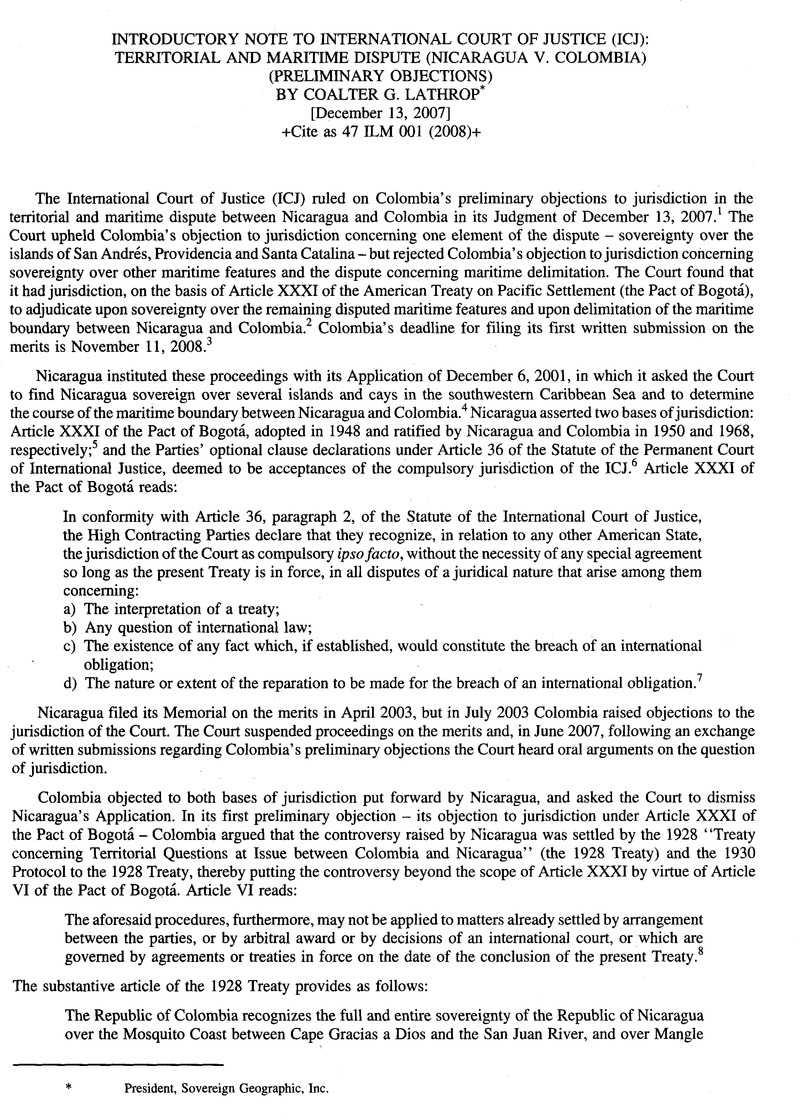No CrossRef data available.
Published online by Cambridge University Press: 27 February 2017

1 See Territorial and Maritime Dispute (Nicar. v. Colom.), (Preliminary Objections) 47 I.L.M 5 (2008) [hereinafter Judgment], available at <http://www.icj-cij.org/docket/files/124/143O5.pdf>. The basic documents, decisions, written pleadings, hearing transcripts, press releases, and other materials of the Court for this case and other ICJ cases are available online at <http://www.icj-cij.org>. This decision should not be confused with the recent ICJ judgment on the merits in the case between Nicaragua and Honduras, in which Nicaragua asserted the same two bases of jurisdiction (without objection from Honduras) and which shared similar subject matter (island sovereignty and maritime delimitation) also in the southwestern Caribbean Sea. See Territorial and Maritime Dispute between Nicaragua and Honduras in the Caribbean Sea (Nicar. v. Hond.), 46 I.L.M. 153 (2007), available at <http://www.icj-cij.org/docket/files/120/14O75.pdf>.
2 Judgment, supra note 1, para. 142. See the Court's map toward the beginning of the judgment for the geographical context of this dispute and the location of several of the disputed maritime features.
3 ICJ Press Release No. 2008/4 (Feb. 11, 2008), available at <http://www.icj-cij.0rg/d0cket/files/l24/14461.pdf>.
4 Judgment, supra note 1, para. 11. The disputed maritime features include San Andrés Island, Providencia Island, Santa Catalina Island, Albuquerque Cays, East-Southeast Cays, Roncador, Serrana, Quitasueño, Serranilla, and Bajo Nuevo. See id. at paras. 12 and 93. In its Memorial, Nicaragua asked the Court to delimit “a single maritime boundary in the form of a median line between these [Nicaragua's and Colombia's] mainland coasts.” Id. at para. 12.
5 American Treaty on Pacific Settlement, Apr. 30, 1948, 30 U.N.T.S. 84 [hereinafter Pact of Bogotá], available at <http://www.oas.org/juridico/english/treaties/a-42.html>. States Parties to the Pact of Bogota include Brazil, Chile, Colombia, Costa Rica, Dominican Republic, Haiti, Honduras, Mexico, Nicaragua, Panama, Paraguay, Peru, and Uruguay. Several other countries, including the United States, have signed but not ratified the Pact.
6 Nicaragua made its declaration in September 1929. Colombia made its declaration in October 1937. Judgment, supra note 1, para. 122.
7 Pact of Bogotá, art. XXXI, supra note 5, at 94, quoted in Judgment, supra note 1, para. 55.
8 Pact of Bogotá, art. VI, supra note 5, at 86, quoted in Judgment, supra note 1, para. 56.
9 Id. at para. 18 (quoting 1928 Treaty, Article I).
10 Id. at para. 20 (quoting 1930 Protocol).
11 Id. at para. 75.
12 Id. at para. 61. For the facts associated with the alleged material breach, see id. at paras. 21-23.
13 Id. at para. 61.
14 See id. at paras. 76-81.
15 Id. at para. 82.
16 Id. at para. 123.
17 Article XXXIV of the Pact reads:’ ‘If the Court, for the reasons set forth in Articles V, VI and VII of this Treaty, declares itself to be without jurisdiction to hear the controversy, such controversy shall be declared ended.” Pact of Bogotá, art. XXXIV, supra note 5, at 96, quoted in Judgment, supra note 1, para. 56.
18 Judgment, supra note 1, para. 123. Colombia also argued that, because Colombia withdrew its declaration on December 5, 2001, the day before Nicaragua filed its Application, the Court could not have jurisdiction on this basis. Finally, Colombia argued that the facts that gave rise to this dispute occurred before January 6, 1932, and would there for be excluded pursuant to a reservation in Colombia's optional clause declaration that read: “The present declaration applies only to disputes arising out of facts subsequent to 6 January 1932.“ Id. at para. 122. The Court did not address either of these arguments after making findings on the basis of Colombia's main argument.
19 Id. at para. 128.
20 Id. at para. 136.
21 Id. at para. 137.
22 Id. at para. 140. Having already found jurisdiction over theother elements of the dispute on the basis of the Pact of Bogota, the Court's analysis of its jurisdiction under the optional clause declarations only related to the three named islands.
23 Nicaragua invoked both Article XXXI of the Pact of Bogotá and the Parties’ optional clause declarations in the Armed Action cases against Costa Rica and Honduras, instituted in 1986, and in its Territorial and Maritime Dispute case against Honduras, instituted in 1999. Costa Rica invoked both bases of jurisdiction in its Navigational and Related Rights case against Nicaragua, instituted in 2005 and which is currently well into the written pleadings phase on the merits. Applications, judgments, pleadings and orders in these cases are available at <http://www.icj-cij.org>.
24 Peru's Application instituting proceedings against Chile is available at <http://www.icj-cij.org/docket/files/137/14385.pdf>.
25 This text was reproduced and reformatted from the text appearing at the ICJ website: (visited January 25, 2008) <http://http://www.icj-cij.org/docket/files/124/14305.pdf>.